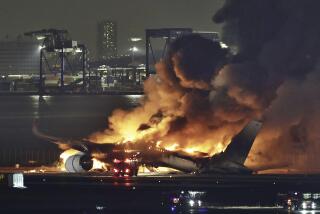For Those Interested in Surviving a Plane Crash, Here’s How to ‘Dress for Success’
- Share via
DAYTON, Ohio — When Greg Jarrells tells an audience how to dress for success, it isn’t to help them get a better job, but to survive an airplane crash.
For the last few months, Jarrells, an engineer at Wright-Patterson Air Force Base, has been advising base workers, and it’s been standing-room-only crowds.
His talk is aimed at those flying on business, but a number of those who fly for a living--lieutenants, captains and majors--also are in the audience.
“I know how to take care of myself in my jet airplane, but I’m not sure I know how to take care of myself in a commercial airliner,” said Maj. Bob Baltzer, who flies F-15 jet fighters.
Evokes Nervousness
Jarrells, 30, a specialist in escape systems who also worked for six years deciphering airplane flight recorder boxes after crashes, peppers his talk with slides of flaming crashes, bringing symptoms of nervousness from the audience.
But no more than 15% of aviation accidents result in fires, and without a fire a person’s chance of survival is 90%, he said. Even with a fire, a person can have a 65% chance of making it out alive, he said, if he remembers to “never, never, never count on anybody else to get you out. Depend only on yourself.”
Jarrells says planning starts at home when getting dressed.
“It’s no greater burden on me to take the time and pick out the things that will give me a leg up on surviving,” Jarrells said.
Loose-weave and fuzzy clothes are out because they don’t keep out heat and more easily catch fire, he said.
Dark colors absorb heat; dresses, skirts and short pants also afford less protection; many synthetics can melt; loose clothing can catch fire and more easily snag; and very tight clothing can let more heat reach the skin.
Jarrells says it’s a myth that leather protects from heat.
If there’s a fire, he said, “that stylish leather coat you were wearing very quickly will become a coat of Saran wrap.”
Multiple layers of light-colored, well-fitting clothing are the best, he said.
Wool is naturally flame retardant, Jarrells said. Other materials, especially synthetics, should be tested by snipping off a small piece and setting it afire. If it melts instead of charring, don’t wear it, he said.
High Heels Are Out
And for women, high-heeled shoes are out, Jarrells said. Not only do they make running difficult, they can puncture escape chutes, he pointed out.
Jarrells says the tail of an airplane isn’t always the safest place to sit.
Although it’s true that “airplanes don’t back into mountains,” Jarrells said, people have been trapped in the tail by flames and smoke.
He prefers to sit in an aisle seat next to the rearmost overwing exit. Jarrells said that way he can head out the nearest exit or, if the crowd crush is too great, he can go with the flow to the front exits.
“I still haven’t figured it out. People in commercial airliner accidents will walk right past an open exit to get to the front door,” he said.
Jarrells, a member of the Aviation Safety Institute in Columbus, said he put the lecture together in his spare time after noting the base had lots of safety presentations, but none on air travel.
He said it took seven or eight months to assemble the material and run it past other experts in the field.
More Hints
Among his other tips:
- Don’t drink. There’s no time for slow reactions in a crash.
- Read the emergency card in the seat pocket. Know how to operate the various doors--each one can be different--and which ones won’t be operable in a water landing.
If you’re not sure of something, ask a cabin attendant.
- Know where the four nearest exits are. And count the seat rows to them. In a fire you may not be able to see the exits, but you can still feel the seats.
- If anyone sitting near an exit seems impaired, tell the attendant. Federal regulations require that able-bodied people sit near all exits. Even the elderly can be impaired when they might have to pull in a 40-pound overwing exit door.
- If you sense anything wrong, get into the brace position of head down and ankles grabbed without waiting for an attendant to tell you.
More to Read
Sign up for Essential California
The most important California stories and recommendations in your inbox every morning.
You may occasionally receive promotional content from the Los Angeles Times.









